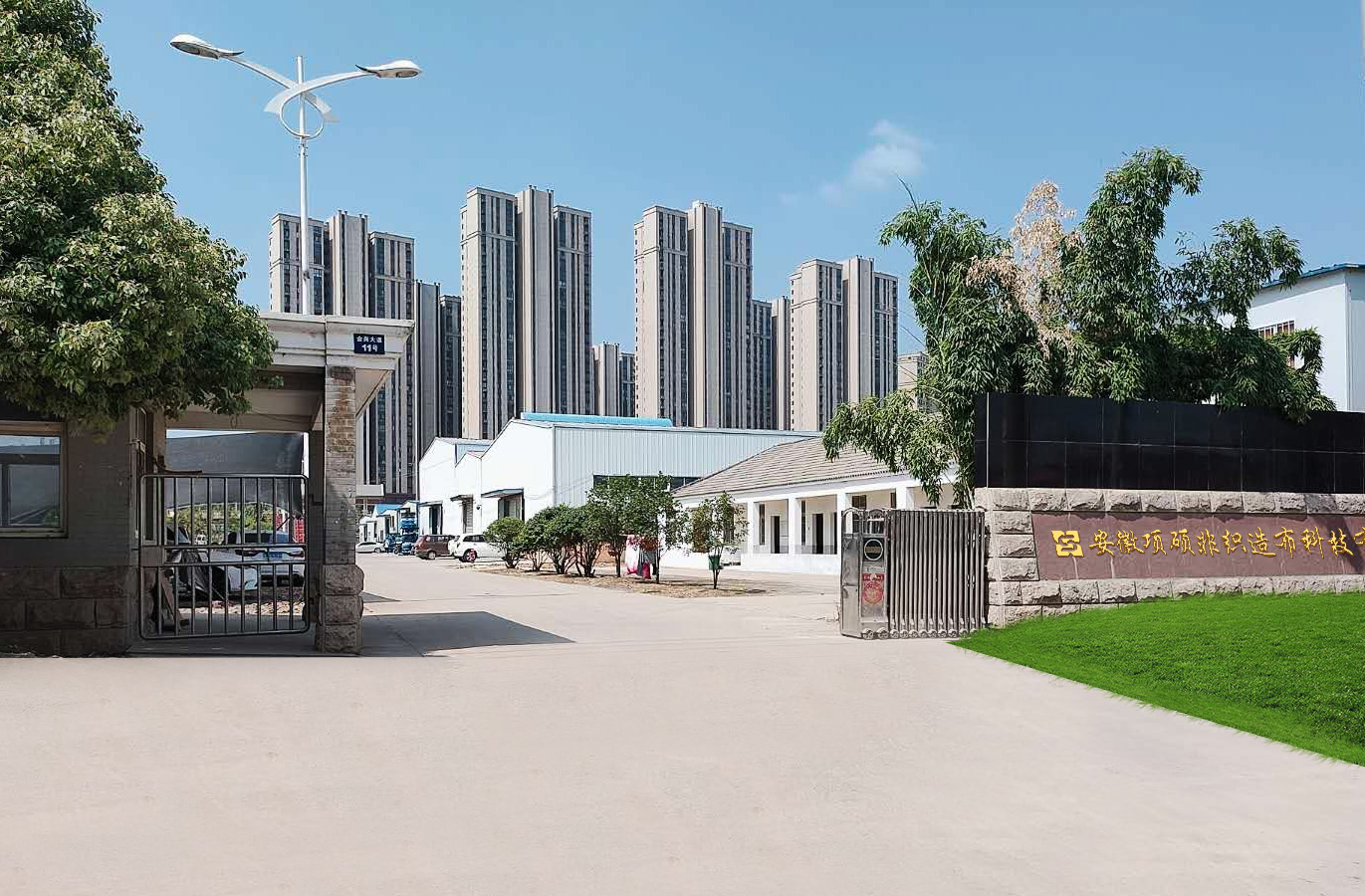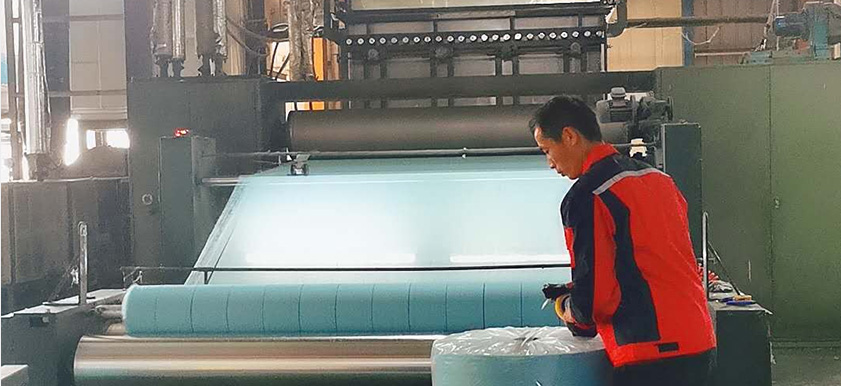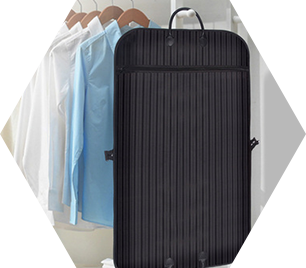

Anhui Xiangshuo Nonwoven Technology Co., Ltd. is located in Wushan Town, Changfeng County, Hefei City, Anhui Province, near Jiangsu, Zhejiang and Shanghai, with convenient transportation and an area of 42 acres. The company was established in July 2019 with a registered capital of 10 million yuan. Committed to the development and production of environmentally friendly nonwoven consumables, it is an emerging production-oriented enterprise with complete equipment and strong technical force, and was rated as a key investment attraction enterprise in Hefei Xinqiao Industrial Zone. The company currently has production lines for PP nonwoven fabrics and polypropylene spunbond nonwoven fabrics, with a width of 1.8 meters to 3.2 meters and a grammage of 9 to 250 g / m². The product has the characteristics of flame-retardant, anti-aging, anti-static, acid and alkali resistance, non-toxic, non-pollution, degradable and other environmentally friendly products. The main scope of our company's experience: R & D, production and sales of non-woven fabrics, non-woven products, and new materials for non-woven fabrics; manufacturing and sales of chemical fiber equipment and non-woven fabric equipment; R & D, production and sales of plastic masterbatch functional master batches; R & D, production and sales of supplies; R & D, production and sales of PE woven tarpaulins, furniture covers, plastic nets, trash cans, and plastic houses.
We always adhere to the principle of "survive by quality, develop by integrity", further improve the management level of the enterprise, achieve the development goals of the enterprise, and strive to become a continuous leader in the industry.
Founder Mr. Xiangxian Jun has 18 years of rich experience in China's non-woven fabric industry. He has developed customers in most parts of the country and overseas markets.
We always adhere to the principle of "survive by quality, develop by integrity", strictly control product quality in production, and always adhere to integrity-based operation.
The company is committed to the development and production of environmentally friendly nonwoven consumables. It is a production-oriented enterprise with complete equipment and strong...




Seedling cultivation, breathable heat preservation and moisturizing, insect control, grass and frost resistance, UV resistance

Filter materials, insulation materials, cement packaging bags, garden warmth, etc.

Surgical gowns, protective clothing, disinfection bags, disposable surgical mattresses, masks, etc.

Sanitary napkins, sanitary pads, diapers, wipes, beauty products, etc.

Furniture covers, non-woven wallpaper, table cloth, etc.

Lining, adhesive lining, non-woven suits, shoes, bags, etc.
Among the numerous industrial materials, there is one that, although not frequently mentioned by the public, has quietly permeated every aspect of our lives. It exists in the wet wipes used in the early morning, within the barriers of hospital protective suits, in the tough texture of supermarket eco-friendly bags, and even covers the surface of farmland to protect crops. This multi-functional material, spunbond nonwoven fabric, can be regarded as the "invisible skeleton" of modern manufacturing.So, what exactly is spunbond nonwoven fabric? How does it differ from traditional textiles and other non-woven fabrics? In simple terms, spunbonding is a one-step process in which chemical fiber raw materials (mainly polypropylene PP) are melted at high temperatures, spun, web-laid, and then directly consolidated into fabric through hot rolling or chemical means. This efficient process enables it to abandon the traditional "spinning + weaving" steps, endowing the product with unique advantages: high strength, good tensile strength, air and water permeability, stable process and controllable cost. These characteristics have enabled it to quickly stand out from numerous non-woven fabric processes (such as needle-punching, spunlace, and meltblown) and become one of the most widely used categories.Why can spunbond nonwoven fabric dominate the market? Its core competitiveness lies in the perfect balance between performance and cost. Compared with the soft-textured short-fiber spunlace fabric, spunbond fabric has a more skeletal feel and is suitable for applications that require shaping. Compared with the meltblown fabric used in the core layer of masks, it offers better base strength and support. From a thin outer layer of a medical mask to a sturdy geotextile, spunbond fabrics of different weights and post-treatments can all handle the job. At present, many leading nonwoven fabric manufacturers are committed to enhancing their functionality, such as developing hydrophilic, antistatic, antibacterial or degradable PP spunbond nonwoven fabrics, in response to the trends of environmental protection and consumption upgrade.Looking to the future, the application boundaries of spunbond nonwoven fabrics are still expanding continuously. With the rise of new energy vehicles, their application prospects in battery separators and interior materials are broad. In the agricultural sector, degradable long-lasting agricultural fabrics reduce white pollution. Personal care products continue to pursue a more comfortable and safer material experience. This seemingly ordinary material, with its solid quality and continuous innovation, is quietly supporting a cleaner, more efficient and healthier world. The next time we come into contact with a disposable medical product or a sturdy packaging bag, we may sense that it is the fundamental technology of spunbond nonwoven fabric that is playing an indispensable role behind it.Anhui Xiangshuo Nonwoven Technology Co., Ltd. is located in Wushan Town, Changfeng County, Hefei City, Anhui Province, near Jiangsu, Zhejiang and Shanghai, with convenient transportation and an area of 42 acres. The company was established in July 2019 with a registered capital of 10 million yuan. Committed to the development and production of environmentally friendly nonwoven consumables, it is an emerging production-oriented enterprise with complete equipment and strong technical force, and was rated as a key investment attraction enterprise in Hefei Xinqiao Industrial Zone. The company currently has production lines for PP nonwoven fabrics and polypropylene spunbond nonwoven fabrics, with a width of 1.8 meters to 3.2 meters and a grammage of 9 to 250 g / m. The product has the characteristics of flame-retardant, anti-aging, anti-static, acid and alkali resistance, non-toxic, non-pollution, degradable and other environmentally friendly products. The main scope of our company's experience: R & D, production and sales of non-woven fabrics, non-woven products, and new materials for non-woven fabrics; manufacturing and sales of chemical fiber equipment and non-woven fabric equipment; R & D, production and sales of plastic masterbatch functional master batches; R & D, production and sales of supplies; R & D, production and sales of PE woven tarpaulins, furniture covers, plastic nets, trash cans, and plastic houses.
MORE+Since 2025, affected by multiple factors such as equivalent tariffs and the global economic downturn, China's textile industry has experienced a complex situation of pressure on foreign trade and intensified competition in domestic trade. Just as industry practitioners are focusing on the development direction for 2026, the Political Bureau of the Central Committee has clearly sent out a key signal - to continue implementing a more proactive fiscal policy. This policy tone has injected strong impetus into the growth of domestic trade in the textile industry and also filled the entire industry with expectations for the development in the New Year. Facing the huge potential of the domestic trade market and the structural challenges at the export end, the textile industry is now at a critical juncture of "stabilizing domestic demand, strengthening resilience, and breaking through internal competition".Foreign trade exports are moving forward under pressure, with both resilience and challenges coexistingAccording to statistics from the General Administration of Customs, from January to November 2025, China's cumulative textile and apparel exports reached 267.8 billion US dollars, a year-on-year decrease of 1.9%, and the overall export performance fell short of expectations. Among them, the export of textiles and garments showed a differentiated trend: The export value of textiles was 130.01 billion US dollars, increasing by 0.9% year-on-year, maintaining a stable growth trend and demonstrating strong industry resilience. The export value of clothing was 137.79 billion US dollars, a year-on-year decrease of 4.4%, with the decline rate expanding compared to before, becoming the main factor dragging down the growth of exports.In terms of RMB, the total export value of textiles and garments from January to November was 1.9 trillion yuan, a year-on-year decrease of 1.2%. To break it down, the export of textiles reached 931.33 billion yuan, increasing by 1.7% year-on-year. Clothing exports reached 987.26 billion yuan, a year-on-year decrease of 3.7%. It is worth noting that the export data for November alone showed positive changes. The export value of textiles and garments in that month was 23.87 billion US dollars, although it decreased by 5.1% year-on-year, it showed a recovery trend month-on-month. Among them, textile exports reached 12.28 billion US dollars, still achieving a year-on-year growth of 1% despite a high base. Clothing exports reached 11.59 billion US dollars, a year-on-year decrease of 10.9%, but the decline narrowed by 5 percentage points compared with October, indicating signs of recovery after the industry's adjustment.The main factors supporting the resilience of exports come from two aspects: First, the China-Us economic and trade consultations have made phased progress, easing the direct pressure brought by trade frictions; Second, overseas markets have entered a seasonal replenishment cycle, which has increased the short-term demand for China's textile and garment products. However, in the medium and long term, the structural risks of global inflation have not yet subsided. Uncertainties such as geopolitical conflicts, the rise of trade protectionism, and non-tariff barriers will continue to disrupt the stability of the global supply chain. Textile export enterprises still need to be vigilant about downside risks.Fiscal policies have been continuously strengthened, and domestic trade has become the core of growthOn December 8th, the Political Bureau of the Central Committee of the Communist Party of China held a meeting to analyze and study the economic work for 2026, clearly stating that "a more proactive fiscal policy will continue to be implemented", which is consistent with the policy tone for 2025 and provides solid policy support for the domestic trade development of the textile industry.Looking back at 2025, as the year when the central government first explicitly implemented a "more proactive" fiscal policy, the policy intensity was unprecedented: The fiscal deficit ratio rose sharply from 3% in 2024 to a historical high of 4%. At the same time, the issuance scale of special Treasury bonds and local government special bonds was expanded. The total amount of new government debt for the whole year was nearly 12 trillion yuan, an increase of nearly 3 trillion yuan compared with 2024. Strong policy input has directly driven the expansion of fiscal expenditure scale. Data from the Ministry of Finance shows that in the first ten months of 2025, the national general public budget expenditure was approximately 22.6 trillion yuan, an increase of 2% year-on-year. The national government-managed fund budget expenditure was approximately 8.1 trillion yuan, increasing by 15.4% year-on-year, effectively promoting the stable operation of the domestic economy.The so-called proactive fiscal policy, also known as expansionary fiscal policy, focuses on stimulating total social demand and promoting economic recovery and growth when economic growth is sluggish through measures such as increasing government spending, expanding the fiscal deficit, issuing government bonds, and raising transfer payments. Since the international financial crisis in 2008, China has consistently adhered to a proactive fiscal policy orientation. The expression "more proactive" implies a further increase in policy intensity, which will directly boost the vitality of the domestic consumer market and create favorable conditions for the growth of domestic trade in the textile industry.For the textile industry, the significance of the domestic trade market will reach an unprecedented height in 2025. Due to the restrictions on foreign trade, a large number of textile enterprises have turned their attention to the domestic market. However, there is still huge potential for demand exploration in China's domestic trade market. The continuous implementation of proactive fiscal policies will further unleash the potential of domestic textile consumption through multiple paths such as stimulating consumption, stabilizing employment, and supporting the real economy, providing a guarantee for the growth of enterprise orders.Declaration: The content of this article is compiled from the Internet and the copyright belongs to the original author. If there is any infringement, please inform us in time and contact us for deletion.
MORE+In today's material market where environmental protection and practicality are given equal importance, PP non-woven fabric, with its unique properties, has gradually become the first choice in many industries. So, what is PP non-woven fabric? What are its advantages and in which fields can it be applied? This article will conduct an in-depth analysis of this material to help you fully understand its value.What is PP non-woven fabric?PP non-woven fabric, fully known as polypropylene non-woven fabric, is a non-woven material directly processed from polypropylene fibers through processes such as meltblown and spunbond. Unlike traditional textiles, it does not require spinning and weaving. Instead, fibers are combined and formed through physical or chemical methods. This production process is not only highly efficient but also significantly reduces energy consumption, making it an economical and environmentally friendly material option.The core advantages of PP non-woven fabricEnvironmentally friendly and degradable: Polypropylene, as a thermoplastic resin, can reduce environmental pollution through recycling and reuse. Some PP non-woven fabrics also support biodegradation, which is in line with the modern concept of sustainable development.Lightweight and durable: PP non-woven fabric is light in weight but has excellent tensile strength and wear resistance, making it suitable for a wide range of usage scenarios.Waterproof and antibacterial: Its hydrophobic property makes it less likely to breed bacteria in damp environments, and it is widely used in medical and hygiene fields.Strong air permeability: The pore structure between the fibers ensures excellent air permeability, making it suitable for clothing and agricultural covering materials.Low cost: The mature industrial production process and low raw material prices make PP non-woven fabric have high cost performance.The wide application fields of PP non-woven fabricMedical and health care: Disposable masks, protective suits, surgical gowns, etc. are all made of PP non-woven fabric to ensure safety and hygiene.Agricultural horticulture: As an insulating and weed control fabric, it helps crops grow and reduces the use of pesticides at the same time.Home packaging: Shopping bags and home storage products are widely popular for their lightness and durability.Industrial filtration: In air and water filtration systems, PP non-woven fabric can effectively intercept particulate matter.Automobile interior: Used for seat cushions and sound insulation materials to enhance driving comfort.
MORE+